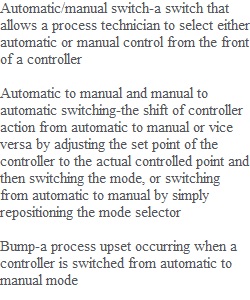


Q PROCESS INSTRUMENTATION CH. 12 KEY TERMS TEST MATCH THE WORDS TO THE DEFINITIONS A. Bump B. Automatic/manual switch C. Bumpless transfer D. Cascade control loop E. Automatic to manual and manual to automatic switching F. Control mode G. Derivative action H. Control valve I. Fail last (fail in place) J. Gain K. Duty cycle L. Integral action (reset) M. Rate action N. Local controller O. Primary controller P. Louvers (dampers) Q. Proportional R. Radio controller S. Tuning T. Uncontrolled flow U. Set point control V. Remote controller W. Split-range controller X. Secondary controller Y. Remote set point 1.__a switch that allows a process technician to select either automatic or manual control from the front of a controller. 2.__-the shift of controller action from automatic to manual or vice versa by adjusting the set point of the controller to the actual controlled point and then switching the mode; or switching from automatic to manual by simply repositioning the mode selector. 3.__-a process upset occurring when a controller is switched from automatic to manual mode. 4.__-the act of changing the controller from manual to automatic (or vice versa) without a significant change in controller output. 5.__-control loop characterized by the output of one controller becoming the set point of another. 6.__the control action or the control algorithm response such as PID or a programmed function. 7.__-the final component of a control loop, operated either remotely or by hand, that receives its signal from the controller and manipulates the process variable in response to a system disturbance or change. 8.__-a controller output response that is proportional to the rate at which the controlled variable deviates from the set point. 9.__-the period of time it takes for a signal to complete an on-and-off cycle. 10.__-the position of the valve seat upon loss of instrument air or power failure. 11.__change in output multiplied by the change in input. 12.__-a controller output response that is proportional to the length of time the controlled variable has been away from the set point. 13.__-when the controller is physically mounted in the processing area near the other instruments in the loop. 14.__-devices used to control airflow. 15.__perceives the secondary loop a separate entity; responds to one process variable (the controlled variable) while the secondary controller responds to another (the manipulated variable). 16.__--the amount of deviation of the controlled variable from the set point required to move the output of the controller through its entire range(expressed as a percent of span). 17.__-the faster the rate of change of the process variable, the greater the output response (derivative action). 18.__-controllers that are designed to ratio (or proportion) flow rate between two separate flows entering a mixing point designed so that its output represents the exact flow rate needed by the controlled flow loop to remain in alignment with the desired ratio to the uncontrolled flow; may also be capable of receiving two separate flow inputs and rationing its output to the control valve located in the control line. 19.__-any controller that is not located in the processing area with the transmitter and control valve. 20.__ set point received from an external source. 21.__a special type of controller, sometimes called a cascade controller or remote set point controller; a standard controller with the added capability of choosing to receive a remote set point from an external source or a local (internal) set point. 22.__ the mechanism by which a technician can manipulate the set point. 23.__where the output signal is divided between two final control element if there are more than two valves, it is called a dual split-range controller. 24.__ adjusting the control action settings so that they produce an appropriate dynamic response to the process resulting in good control. 25.__flow in a process line where there is no control valve. PreviousNext
View Related Questions